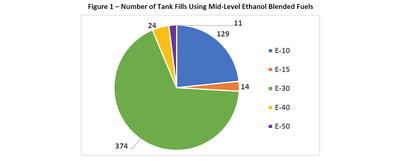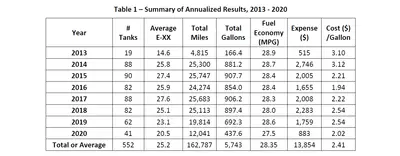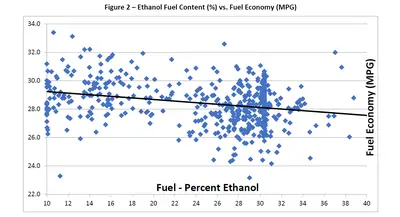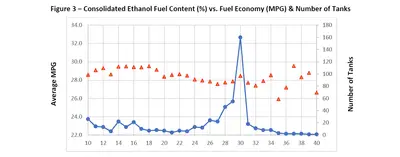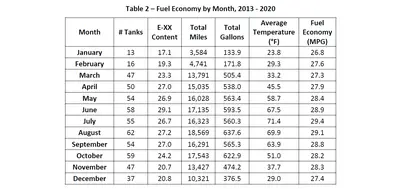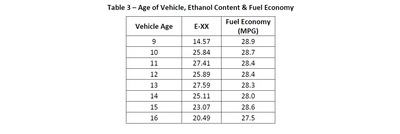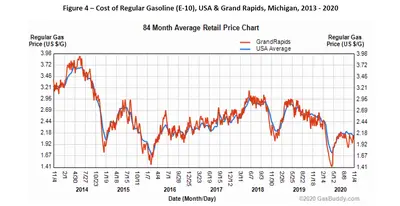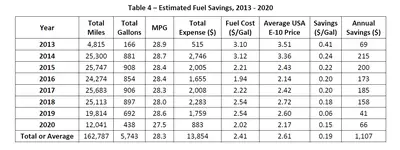Seven Year Hands-On Study Proves Mid-Level Ethanol Blend's Superiority and Benefits
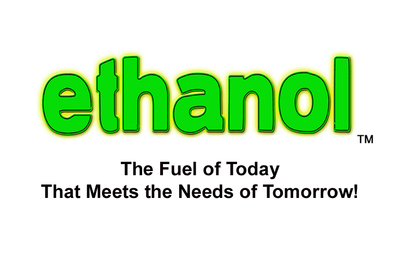 |
William Bosch's Meticulous Analysis Destroys Anti-Ethanol Myths
Introduction by Marc J. Rauch
Exec. Vice President/Co-Publisher
THE AUTO CHANNEL
 Marc Rauch |
There are several anti-ethanol myths that block ethanol's widespread acceptance as an engine fuel - either as a significant partner-ingredient in blends with gasoline, or as a stand-alone fuel. The negative myths were initially invented by the oil industry and their new tool, the American Petroleum Institute, about a century ago to defame ethanol as a likely competitor to their petroleum oil-based fuels. As attempts were made after the 1970's oil crisis to turn to ethanol, as an option to alleviate our dependence on foreign oil and then as an alternative to the poisonous oxygenates favored by the oil industry (tetraethyl lead and MTBE), the negative claims were brought out in force to bash ethanol's prospects. Perhaps the most pernicious of these claims is that ethanol damages the components and parts of internal combustion engines. The second most malicious claim is that ethanol causes inferior performance issues compared to gasoline (less miles-per-gallon of fuel, and less power).
In fact, these negative claims against ethanol are all false. Ethanol is a superior fuel and its use in internal combustion engines is actually beneficial. A new long-term study conducted by William Bosch, a fuel industry professional, proves that the negative claims are false. The importance of Bill Bosch's study is not that it's the first or only one of its kind; it's not. Henry Ford and other pioneers of the automobile industry knew that ethanol is superior to gasoline. General Motors' two leading scientists who were responsible for inventing leaded gasoline, Charles Kettering and Thomas Midgley, knew that ethanol is superior to gasoline. Thousands of tests conducted in 1907-1908 by Departments of the U.S. government proved that ethanol is superior to gasoline. And more recent studies conducted by entities such as Glacial Lakes Energy in South Dakota have proven that ethanol is superior to gasoline.
What makes Mr. Bosch's study so magical is the length of the study (seven years); that it includes ethanol blend levels that are even higher than those that are in common, everyday use in Brazil; and that the test was conducted using a non-flex fuel hybrid vehicle. The reason that the type of vehicle is so momentous is that we (at The Auto Channel) have always felt that the automobile industry made a serious mistake when they didn't market all hybrid vehicles as being capable of using higher level ethanol-gasoline blends. For example, if a standard car running on E10 was rated as getting 25 miles per gallon of gasoline, and a hybrid version of the same model running on E10 was rated as getting 45 miles per gallon of gasoline, that same vehicle running on E50 could lay legitimate claim to be capable of getting 100 or maybe even 200 miles per gallon of gasoline. This is possible by virtue of the fact that half the fuel being used is not gasoline, but rather cleaner, safer ethanol.
Since gasoline emissions are considered to be the most egregious cause of harmful green house gases, then it's obvious how advantageous it would be to instantaneously cut harmful green house gases in half, or down to 25%. And if all hybrid vehicles were also flex fuel vehicles, then using E85 would mean that the vehicles would in effect be capable of getting 400, 500, possibly 600 miles per gallon of "gasoline." Now this instantly cuts harmful green house gases to something like 10% or 5%. These statistics would have made for an incredible marketing headline: "Hey, Buy the All New XXXX Hybrid and Get Up To 600 Miles Per Gallon Of Gasoline!"
There is no sensible reason not to market (and use) hybrid vehicles as being capable of running on mid-level blends, and Bill Bosch's study is further proof that it can be done safely, efficiently, and economically. In this time of uncertainty, when politicians, automakers, and business leaders are grasping at straws to find the best options to address the issues of climate, pollution, health, and the economy, ethanol fuel is the only sure bet.
Friends, readers, fellow inhabitants of our precious planet, we are proud and honored to be able to present to you the exciting case study:
SEVEN YEARS OF USING MID-LEVEL ETHANOL FUELS
By William Bosch*
Process Safety Engineer
CARBON GREEN BIOENERGY
In October 2013, the ethanol plant at which I work (Carbon Green BioEnergy, located in Lake Odessa, MI) installed an ethanol blend pump for public use. I was curious to know how using mid-level ethanol blends (E-15 to E-50) would affect my car’s mileage and performance, so I started recording my fuel economy data for each tank purchased.
I own a 2005 Honda Accord Hybrid with the 3.0 liter, automatic 5 speed, V6 engine rated at 255 HP, curb weight of 3,501 pounds, rated by the EPA at 29 MPG (city) and 37 MPG (highway). It is equipped with Honda’s Integrated Motor Assist System. In 2013, my Accord was already 8 years old with 202,000 miles on the odometer. Over the last seven years I’ve filled my tank 552 times and travelled an additional 162,787 miles. I averaged 294 miles between average tank fills of 10.4 gallons. My Accord is not a flex-fuel vehicle and has not been optimized or modified in any way. It is a stock, single owner, vehicle.
My Accord has always been reliable. Over its lifetime, the majority of my repair and maintenance expenses have been oil changes, brake work, and tires. I replaced the hybrid battery pack at 290,000 miles. Apart from a tune-up, it has never required engine work. This is true both before and after I started to use mid-level ethanol blends.
In addition to being reliable, my Accord has always had good acceleration and performance. Over the last seven years, I’ve never experienced any fuel related problems apart from an occasional check engine dashboard light.
Fuel Choice
Figure 1 shows the number of tank fills using E-10, E-15, E-30, E-40 and E-50. For each tank fill, I relied upon the pump auto-shutoff to stop the pump. When not filling up at work, I normally purchased regular (E-10) gasoline at a station near my home. Overall, I purchased 77% of my fuel at work and I ran with an averaged E-25.2 in my tank.
Over the period of this study, my travel routine has remained consistent. My daily commute is 140 miles using federal and state highways for the majority of the trip. The frequency of my commute has dropped from five days per week prior to 2019 to two to three days per week the last two years. Travel to and from work accounts for an estimated 95% of my total mileage. I drive with the windows closed using the Accord’s AC or heating system. I use my cruise control extensively. Traffic flow is normally light to moderate. The terrain is largely flat, and the roads are paved. I typically drive the speed limit or a bit higher when possible. My Accord receives routine oil changes. Due to the large amount of highway miles, tires changes and brake work is infrequent. Finally, I have another vehicle that I use when needed in the winter months or if my Accord is not available.
Table 1 provides an overview of annualized data showing the number of tank fills, average ethanol content, total miles driven, total gallons purchased, calculated fuel economy, total fuel expense, and average fuel cost per gallon.
Table 1 – Summary of Annualized Results, 2013 - 2020
Study Results
In addition to tracking each tank fill, I calculated the ethanol content actually in the tank. The calculated fuel economy of each tank was then graphed against the ethanol fuel content. All data is shown in Figure 2.
As can be seen, the best fit linear trendline does show a slight downward trend in fuel economy as the ethanol concentration in the fuel increases. However, there is considerable range in the fuel economy for any given ethanol blend. The data displayed in Figure 2 can be simplified by taking the average fuel economy for each incremental percent of ethanol blended.
Figure 3 provides this information along with the total number of tanks used for each incremental blend percent.
The following details emerge from Figure 3.
• I ran 26 tanks on regular (E-10) gasoline using a total of 263 gallons to travel 7,515 miles. My average fuel economy on regular (E-10) gasoline was 28.6 MPG.
• I ran 7 tanks on E-18 using a total of 73 gallons to travel 2,146 miles. My average fuel economy on E-18 was 29.5 MPG, which was the peak fuel economy for any ethanol blend with more than 2 tank fills. I did experience a higher fuel economy on E-37, but the calculated fuel economy was based on only two tanks and 572 miles driven.
• I ran 160 tanks on E-30 using a total of 1,656 gallons to travel 47,142 miles. My average fuel economy on E-30 was 28.5 MPG, basically the same fuel economy that I experienced using regular (E-10) gasoline.
• Finally, I ran 8 tanks on E-34 using a total of 90 gallons to travel 2,566 miles. My average fuel economy on E-34 was 28.5 MPG.
I did experience fuel economies less than 28 MPG for other ethanol blends such as E-26 to E-29 and for some blends over E-30. Overall, I experienced an average fuel economy of 28.3 MPG based on an average ethanol content of 25.2 percent, 5,743 gallons of fuel use and 162,787 miles driven.
I conclude that the ethanol fuel blend, ranging from E-10 to E-30, had little effect on my fuel economy. And, my use of mid-level ethanol fuel blends did not negatively affect vehicle performance and did not require any additional vehicle maintenance. Rather, I suspect that the higher ethanol fuel blends have helped my Accord maintain performance over the last several years allowing it to accumulate 364,000 total miles.
There are many factors other than fuel choice that can affect fuel mileage including weather conditions (temperature, rain, snow, wind speed and direction), traffic conditions, road conditions, driver preferences (speed, windows open/closed, AC use, use of cruise control, etc.), vehicle age, condition and maintenance. My fuel economy study was not set up to evaluate the majority of these possible co-factors. However, I can provide data for two other factors.
Seasonal Effect
There was an obvious effect on fuel economy caused by winter driving conditions in Michigan. Table 2 provides the calculated fuel economy based on the month when the travel occurred. I kept my Accord garaged more often in January and February when the road conditions in Michigan can be awful. I also filled up more often at my local gas station so there is less ethanol content in my fuel during these months.
In addition, cold, dry winter air is denser than warm, humid summer air. This increases the drag or resistance on the Accord in the winter months which increases fuel consumption. Winter normally also comes with higher wind speeds which can increase resistance and fuel consumption.
Table 2 – Fuel Economy by Month, 2013 - 2020
My maximum fuel economy was 29.4 MPG in July (average temperature = 71.4 °F) when running on an averaged E-27 mixture and my minimum fuel economy was 26.8 MPG in January (average temperature = 23.8 °F) running on an averaged E-17 mixture. This represents an 8.8% reduction in fuel economy even with less ethanol in the fuel mixture.
Effect of Vehicle Aging
My Accord was purchased in the fall of 2004, so the vehicle was already 9 years old in 2013. When first purchased, using regular (E-10) gasoline, I calculated highway fuel economy in the 32 to 33 MPG range based on individual tank fills. As can be seen in Table 3, my fuel economy has dropped over the last seven years from an average of 28.9 MPG in 2013 to 27.5 MPG in 2020. This represents a 4.8% drop in fuel economy.
Estimate of Fuel Savings
The cost of my fuel purchases has been recorded and is summarized in Table 1. My fuel cost has ranged from an average high in 2014 at $ $3.15 per gallon to a low in of $1.94 in 2016, with an overall average of $2.42 per gallon.
Figure 4, provided by GasBuddy, charts the average cost of regular (E-10) gasoline in both the USA and in my local fuel market (Grand Rapids, Michigan). As can be seen, my local fuel market tends to follow the national average fairly closely.
Table 4 provides an estimate of my savings due to the purchase of mid-ethanol grade blends based on the difference between the price I paid for my fuel and the average price of regular (E-10) gasoline in the
USA. Overall, I saved about 19 cents per gallon with total seven year savings estimated at $1,107.
Summary
This study represents my driving experience. I used mid-level ethanol blended fuels in my 2005 Honda Accord for seven years, driving a total of 162,787 miles, without experiencing a significant reduction in fuel economy. My data points to at least two factors that appear to be more associated with lower fuel economy, seasonal changes and vehicle age, than ethanol content. I was not able to evaluate multiple other factors that could also be associated with more significant reductions in fuel economy.
In my opinion, the use of mid-level ethanol fuels has helped to maintain engine performance as my Accord has aged. With 364,000 miles on the odometer it is still running well. I also saved over $1,000 by purchasing lower cost ethanol blended fuels.
* About Bill Bosch
William Bosch is the Process Safety Engineer at Carbon Green BioEnergy, located in Lake Odessa, MI. He earned a BS in Chemical Engineering from Michigan State University and a MS in Industrial Health from the University of Michigan. He has worked 35 years in the Environmental, Safety and Health field.




